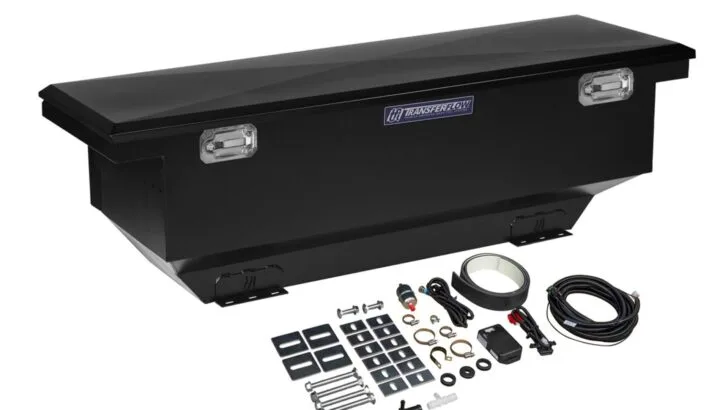Pickup trucks are known for their versatility and utility. In the RV world, they’re popular for everything from the heavy-duty hauling of large travel trailers, fifth wheels, and toy haulers to serious overlanding excursions. However, heavy-duty hauling consumes a fair amount of extra fuel, limiting the distance a truck can travel on its own tank. Therefore, some pickup truck owners opt to use an auxiliary fuel tank.
So, let’s look at the benefits, regulations, and necessary considerations for using auxiliary fuel tanks.
What Is an Auxiliary Fuel Tank?
An auxiliary fuel tank is an additional fuel storage container designed to supplement the existing fuel tank of a vehicle. Most auxiliary tanks are installed into the bed of the truck.
However, there are also under-bed auxiliary fuel tanks for pickup trucks. The tanks are attached to the truck’s frame under the bed, allowing for more space and easy access to the bed. They’re generally smaller (due to limited space) and they’re harder to install (leading many truck owners to choose to have this type of tank installed professionally).
Auxiliary tank systems are designed to feed additional fuel into the truck’s existing fuel fill system. Gravity-feed auxiliary fuel tanks use gravity to feed the fuel into the vehicle’s existing filler tube, which means that the onboard tank remains full until the auxiliary tank is turned off or emptied.
However, gravity feed tanks aren’t always an option for gasoline-fueled trucks because certain types of gravity feed systems are illegal. (More on that in a minute.)
Note that an auxiliary fuel tank is not the same as a transfer tank. While a transfer tank is also designed to store fuel in the bed of a pickup truck, it differs in its purpose. Instead of being used to augment the fuel capacity of the vehicle it’s installed in, it’s used to fill the tanks of other fuel-powered devices such as landscaping or construction equipment, ATVs, etc. These use a pump, hose, and handle to transfer the fuel into the tank of the equipment.
On the other hand, auxiliary fuel tanks are only designed to feed the fuel (gas or diesel) into the truck’s fuel system automatically.
What Are the Benefits of an Auxiliary Fuel Tank?
An auxiliary fuel tank offers several benefits, the most obvious of which is the ability to travel longer distances without needing to find and stop for additional fuel for a refill.
Extended Range/Remoteness of Travel
The truck’s travel distance is significantly increased with an auxiliary tank onboard. This is beneficial for long-distance driving, off-road adventures, and for towing heavy loads (like 5th wheels, toy haulers, etc.) that tend to increase fuel consumption.
The extra fuel capacity provided by an auxiliary tank allows a greater distance to be traveled before refueling at a station becomes necessary.

If your adventures take you waaaaay off-road, it’s great to have extra fuel to ensure you don’t run out on the way back.
Added Versatility
Pickup trucks are useful for a wide range of tasks, but if overlanding, off-roading, and adventure camping is your thing, an auxiliary fuel tank may mean the difference between being forced to camp closer to civilization or adventuring much further off the beaten path without worrying about running out of fuel.
Reduced Fuel Costs
The ability to carry more fuel means that a driver can take advantage of fueling stations with the best prices as well as any real discounts available. (Before you buy the hype on diesel fuel discount programs, be sure to check out our post on the topic!) This can lead to substantial savings in fuel costs over time.
Less Need for Frequent Stops
Frequent stops for refueling can be incredibly annoying and can even take you off your path, depending on where you’re traveling. This is especially true of a truck hauling a heavy load that consumes a fair amount of fuel.
An auxiliary fuel tank reduces the need to stop for fuel, allowing you to keep on going to your destination… without spending time locating and using a fueling station.
Auxiliary Fuel Tanks: Things to Consider
While auxiliary fuel tanks offer numerous benefits, there are several things to consider before installing one in your pickup truck.
Legal Regulations
While we can’t get into the details in a short blog post, many federal, state, and regional regulations need to be considered when installing an auxiliary fuel tank, especially a gravity-fed system. It’s important to adhere to regulations governing the installation and use of auxiliary fuel tanks.
For example, although the installation of auxiliary tanks for gasoline is very similar to the installation of diesel tanks, it’s illegal to gravity feed from the bottom of a gasoline auxiliary tank. By law, the fuel has to be pulled from a fitting on top of the auxiliary tank, which requires a pump to transfer the gas from the auxiliary tank to either the engine or the truck’s gas tank.
So, gravity-fed auxiliary gas tanks are illegal, and both gas and diesel fuel tanks must comply with strict regulations and laws. This is important for many reasons. For example, fuel that leaks from a rollover valve on a gravity-fed system presents a significant fire hazard. There’s also a potential for fire if a gravity-fed system overfills the main fuel tank and fuel is introduced into the vapor space. The tank pressure is an additional safety consideration.
Transfer Flow, perhaps the biggest name in the auxiliary tank space, has excellent explanations of fuel regulations and concerns on its website. However, since different states and regions may have additional specific regulations governing the installation and use of auxiliary fuel tanks, be sure to research and adhere to these regulations to avoid legal issues.
Size and Shape of the Tank
The size and shape of the tank (most often placed in the bed of the truck) need to be considered, especially if you’re towing a 5th wheel since the 5th wheel hitch takes up a lot of bed space. Not only is adequate space in the truck bed a concern, but it’s also possible that the 5th wheel could hit the auxiliary tank when maneuvering, presenting a dangerous situation that must be avoided.
Note that some auxiliary fuel tanks include integrated storage boxes to add functionality, allowing the user to get use out of otherwise wasted space. This is especially important because you’re giving up a fair amount of space in the bed of the truck for the tank itself (this would be less of a concern with long bed trucks).

This combination auxiliary fuel tank and toolbox allows the truck owner to take advantage of the storage space provided by the box on the tank. (Photo source: Transfer Flow)
Weight Distribution
Adding a heavy auxiliary tank to your pickup truck’s bed can affect the weight distribution. It’s important to make sure the tank’s weight doesn’t compromise the truck’s handling or towing capabilities. Proper installation and balancing are critical to your safety and the safety of those traveling near you.
Maintenance
An auxiliary fuel tank requires regular maintenance and checks to ensure it’s in proper working condition and isn’t dangerous. Regularly checking for leaks, inspecting fittings, and cleaning the tank whenever necessary are extremely important.
Budget
The cost of purchasing and installing an auxiliary fuel tank varies depending on the tank’s size, material, and complexity of the installation, but it’s not an inexpensive proposition. But, adding an auxiliary fuel tank may make sense in terms of expense depending on how you travel and how much of a difference the auxiliary tank will make in your use case. For some truck owners, however, the cost wouldn’t be justified.
Where to Buy an Auxiliary Fuel Tank
Let’s take a look at a few of the leading suppliers of auxiliary tanks, kits, and related accessories.
Transfer Flow Auxiliary Fuel Tanks
Transfer Flow is the clear leader in this space. They have an excellent reputation for high-quality products with a relatively high price tag to match. But while Transfer Flow products may cost more at the outset, you know you’re getting a top-quality product.
Transfer Flow has a wide variety of sizes and types of aluminized steel fuel tanks to choose from. They also offer install kits and accessories, including filler necks, fuel lines, fuel caps, hose clamps, and more.
Transfer Flow does installations or assists you in scheduling a professional installation near you. They can also supply you with everything you need to do the installation yourself.
Here’s a video on how to mount a Transfer Flow auxiliary tank in the bed of a pickup truck:
ATTA – Aluminum Tank & Tank Accessories, Inc.
ATTA also offers a wide variety of auxiliary tanks including tank & toolbox combination tanks, under-bed-cover tanks, wedge-style tanks, L-shaped tanks, and more. They have installer locations throughout the country.
Like other manufacturers of auxiliary tanks, ATTA doesn’t sell auxiliary fuel tanks for gasoline trucks due to DOT and EPA regulations. Their auxiliary tanks and fuel systems are for diesel fuel only, though they do offer legal gasoline transfer tanks.
JME Ellsworth Aux Tanks
JME Ellsworth sells a wide variety of products including auxiliary fuel tanks and install kits.
Their tanks come in a wide variety of shapes and sizes. JME sells its own products along with tanks & equipment from many different manufacturers (including Transfer Flow).
Do-It-Yourself Kit
It’s also possible to purchase a tank and a kit and do the installation yourself, but it’s critical to abide by all safety regulations and make sure the installation is done safely.
With this approach, you would purchase a tank of the type, size, and shape you need and an auxiliary fuel tank kit for installation.
- Product Type:Auto Accessory
- Item Package Dimension:54.61 Centimeters L X 59.69 Centimeters W X 134.62 Centimeters H
- RDS offers a full assortment of tanks in various capacities and dimensions to fit your needs
- Gasoline auxiliary fueling is allowed, if siphoned from the top of the tank by using an electric fuel pump
Whether you want to extend your truck’s range to get further off the beaten path, or simply because you’re interested in reducing the number of times you need to stop for fuel, an auxiliary fuel tank could be a helpful addition to your truck.
Free RVing Tips, Tricks, Reviews & Giveaways
As 20-year full-timers, we share everything we’ve learned about RVing over the years. Join our online community to receive a wealth of great RVing knowledge delivered daily to your inbox.
Whether you’re a new RVer or a seasoned full-timer, you’ll love the wide range of RVing topics we cover. Don’t miss a single article or any of our famous Giveaways. Subscribe to our newsletter today!




Mark Laffin
Monday 9th of October 2023
You briefly mentioned under-bed fuel tanks but, didn’t devote any additional commentary to them. I did a lot of research on auxiliary fuel tanks for my 2011 Ford F350 diesel tow vehicle. I considered various configurations of in-bed and below-bed tanks and finally settled on replacing my original factory-installed 26-gallon tank with a 50-gallon tank from Titan Fuel Tanks (https://titanfueltanks.com//ford-crew-cab-short-bed-super-series-2011-2016-7020211). The tank reuses the OEM pump and instrument assembly and fits in the same space as the OEM tank; it hangs about an inch lower than the OEM tank. The truck computer has to be reprogrammed so it is aware of the larger tank capacity so the fuel gauge and trip computer calculations are correct. I didn’t want to deal with additional pumps, switches, hoses, and loss of space in the truck bed. My towing range doubled to 600 miles with the new tank. I’ve used the Titan tank for 3 years without any problems whatsoever; I’m very pleased with my choice and can recommend it to others.